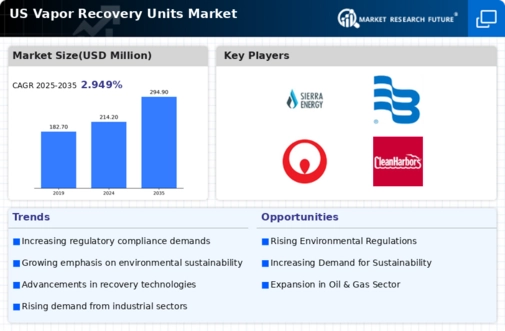Environmental Regulations and Standards
The vapor recovery-units market is experiencing a notable surge due to stringent environmental regulations imposed by federal and state agencies in the US. These regulations aim to minimize volatile organic compound (VOC) emissions from industrial processes, particularly in the oil and gas sector. As a result, companies are increasingly investing in vapor recovery systems to comply with these mandates. The Environmental Protection Agency (EPA) has set forth guidelines that necessitate the installation of vapor recovery units at various facilities, which has led to a projected market growth of approximately 8% annually. This regulatory landscape not only drives demand but also encourages innovation within the vapor recovery-units market, as manufacturers strive to develop more efficient and compliant technologies.
Increased Demand from the Oil and Gas Sector
The oil and gas sector remains a primary driver of the vapor recovery-units market, as companies seek to mitigate emissions and comply with regulatory requirements. The extraction and processing of hydrocarbons generate substantial amounts of VOCs, necessitating the implementation of effective vapor recovery solutions. As the industry continues to evolve, the demand for vapor recovery units is expected to rise, with estimates suggesting a growth rate of 6% annually in this segment. This trend is further supported by the increasing focus on operational efficiency and cost reduction within the sector. Consequently, the vapor recovery-units market is likely to see sustained interest from oil and gas companies aiming to enhance their environmental performance.
Economic Incentives and Funding Opportunities
Economic incentives and funding opportunities provided by government programs are playing a crucial role in the expansion of the vapor recovery-units market. Various federal and state initiatives offer financial assistance to companies that invest in pollution control technologies, including vapor recovery systems. These incentives can significantly reduce the initial capital expenditure required for installation, making it more feasible for businesses to adopt these technologies. For instance, grants and tax credits can cover up to 30% of the costs associated with implementing vapor recovery units. This financial support is expected to stimulate market growth, as more companies are likely to pursue these technologies to enhance their operational efficiency while benefiting from economic advantages.
Rising Awareness of Environmental Sustainability
There is a growing awareness among industries regarding the importance of environmental sustainability, which significantly impacts the vapor recovery-units market. Companies are increasingly recognizing the need to adopt practices that reduce their carbon footprint and enhance their corporate social responsibility. This shift in mindset is prompting investments in vapor recovery technologies, as they are seen as essential tools for achieving sustainability goals. The market is projected to grow by 7% over the next five years, driven by this heightened focus on eco-friendly practices. As organizations strive to meet consumer expectations for sustainable operations, the vapor recovery-units market is likely to benefit from increased adoption across various sectors, including petrochemicals and manufacturing.
Technological Innovations in Vapor Recovery Systems
Technological innovations are reshaping the vapor recovery-units market, leading to enhanced efficiency and performance. Recent advancements in materials and design have resulted in more effective vapor recovery systems that can capture a higher percentage of emissions. For example, the introduction of advanced membrane technologies and improved compressor designs has increased the recovery rates to over 95% in some applications. This trend is likely to continue, as manufacturers invest in research and development to create more sophisticated solutions. The ongoing evolution of technology not only boosts the operational capabilities of vapor recovery units but also aligns with the growing demand for cleaner industrial processes, thereby propelling market growth.















Leave a Comment